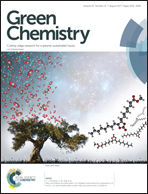Hydrodeoxygenation of cellulose pyrolysis model compounds using molybdenum oxide and low pressure hydrogen†
Abstract
A molybdenum oxide catalyst in a low pressure hydrogen atmosphere was used for the hydrodeoxygenation (HDO) of pulsed injections of cellulose pyrolysis model compounds to examine reaction products. Higher catalyst loadings (≥20 : 1 catalyst : cellulose injection) in the HDO reactor were found to preferentially produce alkanes, while at lower loadings (≤10 : 1 catalyst : cellulose injection) alkene selectivity was increased. However, as the amount of catalyst was decreased, the pyrolysis vapors were not completely deoxygenated. The HDO of monofunctional oxygenated C4 compounds found hydroxyl groups to be the most readily reacted and ether linkages to be the most recalcitrant. In general, the reactivity towards deoxygenation of the tested oxygen-containing functional groups was observed to be C–OH > C![[double bond, length as m-dash]](https://www.rsc.org/images/entities/char_e001.gif) O > C–OC. Several cellulose pyrolysis model compounds were also tested, including methyl glyoxal, glycolaldehyde, furfural, 5-hydroxymethylfurfural, and levoglucosan, and found the same general trend to occur, except for levoglucosan, which was totally reacted and did not yield any oxygenated low molecular weight compounds despite containing two ether linkages. Across the compounds, the general reaction pathway was observed to include carbonyl/alcohol hydrogenation/dehydrogenation, deoxygenation, and alkene isomerization and hydrogenation.
O > C–OC. Several cellulose pyrolysis model compounds were also tested, including methyl glyoxal, glycolaldehyde, furfural, 5-hydroxymethylfurfural, and levoglucosan, and found the same general trend to occur, except for levoglucosan, which was totally reacted and did not yield any oxygenated low molecular weight compounds despite containing two ether linkages. Across the compounds, the general reaction pathway was observed to include carbonyl/alcohol hydrogenation/dehydrogenation, deoxygenation, and alkene isomerization and hydrogenation.



 Please wait while we load your content...
Please wait while we load your content...